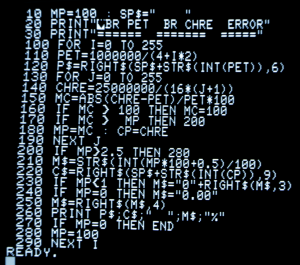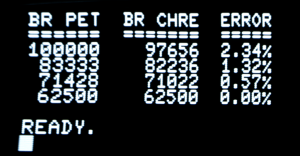When trying to communicate over a serial link, it’s essential to make sure that both sides use the same bit rate. Usually a small mismatch is allowed, depending on the ‘intelligence’ of the involved circuits, but we strive for a 100% match to get the most reliable connection.
In our case, both devices are dividing the system base clock by a specific factor to define a bit rate. These factors are integers, therefore we can not always do an exact division of the system frequency to get the bit rate wanted.
We’ve seen in a previous post that the PET’s highest bit rate (under control of timer 2) is 250,000 bit/s. Of course we’d like to use this bit rate for best data throughput. The ATmega1284p datasheet specifies the following equations for calculating the bit rate and for calculating the value for the USART Baud Rate Register (UBRR):
UBRR = system clock frequency / (16 * BAUD) – 1
BAUD = system clock frequency / (16 * (UBRR + 1))
To get the desired 250,000 bit/s we must set UBRR to
25,000,000 / (16 * 250,000) – 1 = 5.25
The integer closest to this real is 5. Now we double check:
BAUD = 25,000,000 / (16 * (5 + 1)) = 260,416.6667
Oops! That’s more than 4.1 percent off! According to the datasheet, the maximum baud rate error must not exceed +/-2.5 percent. So, our next job is to find the highest bit rate where the mismatch is less or equal to 2.5 percent. Now the PET’s number crunching power comes in handy:
Programmed on the real hardware. For small BASIC programs that’s still ok (kind of), but for Assembler I will switch to CBM prg Studio and VICE!
These are the highest bit rates:
62,500 bit/s is four times slower than what we hoped for. Anyway, that’s the bit rate to start with. If the software on both sides of the serial connection is running flawlessly, we may try the other three rates…

